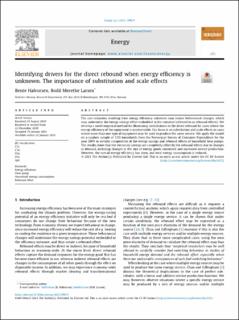| dc.contributor.author | Halvorsen, Bente | |
| dc.contributor.author | Larsen, Bodil Merethe | |
| dc.date.accessioned | 2022-03-21T10:42:26Z | |
| dc.date.available | 2022-03-21T10:42:26Z | |
| dc.date.created | 2021-04-30T18:22:05Z | |
| dc.date.issued | 2021-05 | |
| dc.identifier.citation | Energy, 222 (May), 119879. | en_US |
| dc.identifier.issn | 0360-5442 | |
| dc.identifier.uri | https://hdl.handle.net/11250/2986405 | |
| dc.description.abstract | The cost reduction resulting from energy efficiency initiatives may induce behavioural changes, which may undermine the energy savings effort embedded in the initiative (referred to as rebound effects). We develop a novel empirical method for illustrating contributions to the direct rebound for cases where the energy efficiency of the equipment is unobservable. Our focus is on substitution and scale effects in cases where more than one type of equipment may be used to produce the same service. We apply the model on a random sample of 1111 households from the Norwegian Survey of Consumer Expenditure for the year 2009 to identify components of the energy savings and rebound effects of household heat pumps. The results show that the electricity savings are completely offset by the rebound effects due to changes in demand, including changes in the mix of energy goods consumed and increased service production. However, the overall energy efficiency has risen, and total energy consumption is reduced. | |
| dc.language.iso | eng | en_US |
| dc.publisher | Elsevier | en_US |
| dc.title | Identifying drivers for the direct rebound when energy efficiency is unknown. The importance of substitution and scale effects. | en_US |
| dc.type | Peer reviewed | en_US |
| dc.type | Journal article | en_US |
| dc.description.version | publishedVersion | |
| dc.source.volume | 222 | en_US |
| dc.source.journal | Energy | en_US |
| dc.identifier.doi | 10.1016/j.energy.2021.119879 | |
| dc.identifier.cristin | 1907535 | |
| dc.source.articlenumber | 119879 | en_US |
| cristin.ispublished | true | |
| cristin.fulltext | original | |
| cristin.qualitycode | 2 | |
